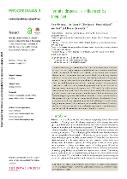| dc.contributor.author | Hellemans, Simon | |
| dc.contributor.author | Šobotník, Jan | |
| dc.contributor.author | Lepoint, Gilles | |
| dc.contributor.author | Mihaljevič, Martin | |
| dc.contributor.author | Roisin, Yves | |
| dc.contributor.author | Bourguignon, Thomas | |
| dc.date.accessioned | 2023-06-06T08:03:48Z | |
| dc.date.available | 2023-06-06T08:03:48Z | |
| dc.date.issued | 2022 | |
| dc.identifier.uri | https://hdl.handle.net/20.500.14178/1934 | |
| dc.description.abstract | Termites feed on vegetal matter at various stages of decomposition. Lineages of wood- and soil-feeding termites are distributed across terrestrial ecosystems located between 45 °N and 45 °S of latitude, a distribution they acquired through many transoceanic dispersal events. While wood-feeding termites often live in the wood on which they feed and are efficient at dispersing across oceans by rafting, soil-feeders are believed to be poor dispersers. Therefore, their distribution across multiple continents requires an explanation. Here, we reconstructed the historical biogeography and the ancestral diet of termites using mitochondrial genomes and δ(13)C and δ(15)N stable isotope measurements obtained from 324 termite samples collected in five biogeographic realms. Our biogeographic models showed that wood-feeders are better at dispersing across oceans than soil-feeders, further corroborated by the presence of wood-feeders on remote islands devoid of soil-feeders. However, our ancestral range reconstructions identified 33 dispersal events among biogeographic realms, 18 of which were performed by soil-feeders. Therefore, despite their lower dispersal ability, soil-feeders performed several transoceanic dispersals that shaped the distribution of modern termites. | en |
| dc.language.iso | en | |
| dc.relation.url | https://doi.org/10.1098/rspb.2022.0246 | |
| dc.rights | Creative Commons Uveďte původ 4.0 International | cs |
| dc.rights | Creative Commons Attribution 4.0 International | en |
| dc.title | Termite dispersal is influenced by their diet | en |
| dcterms.accessRights | openAccess | |
| dcterms.license | https://creativecommons.org/licenses/by/4.0/legalcode | |
| dc.date.updated | 2023-12-22T13:40:34Z | |
| dc.subject.keyword | Isoptera | en |
| dc.subject.keyword | biogeography | en |
| dc.subject.keyword | ecology | en |
| dc.subject.keyword | feeding group | en |
| dc.subject.keyword | stable isotopes | en |
| dc.subject.keyword | mitogenomes | en |
| dc.relation.fundingReference | info:eu-repo/grantAgreement/UK/COOP/COOP | |
| dc.relation.fundingReference | info:eu-repo/grantAgreement/UK/PROGRES/Q45 | |
| dc.date.embargoStartDate | 2023-12-22 | |
| dc.type.obd | 73 | |
| dc.type.version | info:eu-repo/semantics/publishedVersion | |
| dc.identifier.doi | 10.1098/rspb.2022.0246 | |
| dc.identifier.utWos | 000807180900006 | |
| dc.identifier.eidScopus | 2-s2.0-85131106035 | |
| dc.identifier.obd | 620356 | |
| dc.identifier.riv | RIV/00216208:11310/22:10452697 | |
| dc.identifier.pubmed | 35611530 | |
| dc.subject.rivPrimary | 10000::10600::10618 | |
| dc.relation.datasetUrl | https://doi.org/10.5061/dryad.41ns1rngs | |
| dcterms.isPartOf.name | Proceedings of the Royal Society B: Biological Sciences | |
| dcterms.isPartOf.issn | 0962-8452 | |
| dcterms.isPartOf.journalYear | 2022 | |
| dcterms.isPartOf.journalVolume | 289 | |
| dcterms.isPartOf.journalIssue | 1975 | |
| uk.faculty.primaryId | 115 | |
| uk.faculty.primaryName | Přírodovědecká fakulta | cs |
| uk.faculty.primaryName | Faculty of Science | en |
| uk.department.primaryId | 1063 | |
| uk.department.primaryName | Ústav geochemie, mineralogie a nerostných zdrojů | cs |
| uk.department.primaryName | Institute of Geochemistry, Mineralogy and Mineral Resources | en |
| dc.type.obdHierarchyCs | ČLÁNEK V ČASOPISU::článek v časopisu::původní článek | cs |
| dc.type.obdHierarchyEn | JOURNAL ARTICLE::journal article::original article | en |
| dc.type.obdHierarchyCode | 73::152::206 | en |
| uk.displayTitle | Termite dispersal is influenced by their diet | en |

